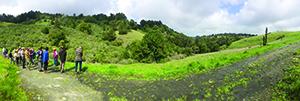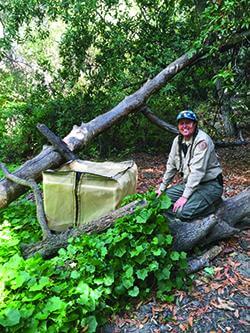IPM Goals | Annual Reports | Methodology | Plant Pathogen | Invasive Species | Resources
An important part of the Park District’s stewardship work is preventing and controlling pests. This is done in a sustainable and ecologically-minded way by using the principles of Integrated Pest Management (IPM). The Park District’s IPM program is an essential activity to maintain healthy ecosystems that benefit plants, wildlife, and the quality of park experience for our visitors.
IPM is a widely accepted, science-based approach used to effectively reduce pest populations while minimizing hazards to human health and the environment. A "pest" is any organism that causes damage to human health, recreation, or ecological function.
By far, the largest volume of pests in the Park District are weeds that degrade recreational enjoyment of open spaces and increase fire risk. The Park District’s IPM program also targets weeds that threaten biological diversity and ecological function. Additionally, the IPM program controls organisms such as harmful algal blooms, ticks, yellow jackets, rattlesnakes, rats, and mice; all of which pose threats to public health.
» Learn more about Integrated Pest Management
IPM Goals
The principal goals of the Park District’s IPM program are:
- Healthy Forests – Park District wide efforts to reduce risk of catastrophic fire in the wildland and urban interface.
- Public Health – Remediation of pests that pose a threat to public health, such as treatment for ticks, E. coli, and harmful algal blooms.
- Ecological Function – Vegetation and pest management to promote and maintain sensitive natural resources and increase biodiversity. This broad category includes habitat enhancement, ecological restoration projects, and environmental programs.
- Safe and Accessible Recreation – Vegetation management to maintain recreational use, including landscaping, gardens and other recreational uses.
- Fire Safety – Vegetation management around ignition sources, building perimeters and fire access areas that are prone to ignition and/or in fire prone areas. These access areas include trails, roads, barbecues and fire pits, campgrounds, high use picnic areas, parking lots, buildings, and infrastructure perimeters.

Annual IPM Reports [PDFs]
2023 | 2022 | 2021 | 2020 | 2019 | 2018 | 2017 | 2016 | 2015 | 2014
Presentation on 2018 Program: April 10, 2019 (PPT Deck, 23 pp.)
IPM Methodology
IPM is not a single pest control method but rather an approach that weighs the benefits and potential hazards of multiple control options and helps identify on the optimum combination of methods for a given situation.
Prevention, Monitoring and Identification of Potential Pests

As a first line of pest control, the IPM programs work to prevent the introduction and spread of pests. This can be done by identifying potential pathways of introduction and limiting risk. For instance, making sure that equipment used in natural areas has been cleaned so that it does not move weed seeds to a new site.

Active monitoring of areas that are at high risk for introduction, like trailheads, can help to locate new introductions quickly so that appropriate control actions can be determined and implemented early. Additionally, monitoring after treatment is part of evaluating efficacy.
The Park District trains its staff every year in identification, mapping, and monitoring for new threats to our wildlands and outdoor activities. The public is also invited to map weeds through the Calflora mobile platform. Staff use data from this valuable community science tool to focus efforts and prioritize actions.
Control Methods

IPM includes a range of control methods types. Including: cultural, mechanical, biological, or chemical. Using multiple methods together typically provides the strongest approach. Through adaptive management the approach can be fine-tuned by gauging success over time. The Park District prioritizes and emphasizes cultural, mechanical, and biological controls or a combination of these before considering chemical controls.
• Cultural controls are changes to the environment that disrupt the ideal pest conditions and decrease pest population. Examples of cultural control methods include mulching, grazing, competitive planting with native plants, and watering responsibly to control soil moisture. Over 85,000 acres, 68% of our lands use grazing to provide fuels control and improve biological diversity.

• Mechanical control is the management of pests by physical means. Mechanical control methods include hand pulling, digging, mowing, and line trimming. The Park District prioritizes mechanical methods to control vegetation along roads and trails. Fire roads and trails are rough mowed or line trimmed. Fencing is line trimmed, as are most group camps and other recreational areas.
• Biological control utilizes natural or introduced enemies of a pest, such as an inset that feeds on a pest plant, to reduce the ability of the pest to spread. Additionally, the IPM program works collaboratively with researchers from the USDA-Agricultural Research Service to introduce host-specific biocontrol agents for specific weeds.
• Chemical controls include the use of organic and conventional registered products that are used to control plants, insects, fungi, or other pests. Organic and conventional herbicides are used when mechanical and cultural methods are ineffective. Organic and conventional or organic products are never used in and around play structures and drinking fountains.
Plant Pathogen
East Bay Regional Park District is experiencing a new plant disease epidemic. This plant disease was first detected in 2012 in a native plant nursery and then in 2014/2015 in a restoration site in the Bay Area. After initial detection, over 50 different plant pathogens were identified in plant nurseries and restoration sites. Nurseries have been determined to be the cause of the new diseases in our parklands and restoration sites. The source of these plant diseases is a fungus-like organism that lives on plant roots called Phytophthora, which means “Plant Destroyer.” It is transmitted by contaminated nursery stock, the introduction of contaminated soil, vegetation, dirty equipment, and water. It is important to be aware of and take measures to protect natural areas from these virulent pathogens. Visit our Plant Pathogen page for More Info.
Invasive Species
Invasive Weed Brochures
Invasive Weed Identification Guides
Resources
- California Invasive Plant Council (Cal-IPC)
- California Department of Fish and Wildlife
• Invasive Species Program
• Rodenticides - University of California Cooperative Extension Weed Research and Information Center
- Center for Invasive Species and Ecosystem Health – California Noxious Weeds
- California Oak Mortality Task Force on Sudden Oak Death
- PlantRight.org - promoting noninvasive horticultural plants
- Ticks and Lyme Disease
- Alameda County Vector Control
- Contra Costa - Mosquitos & Vector Control District
